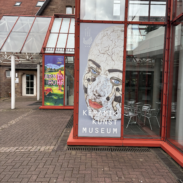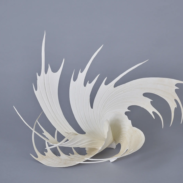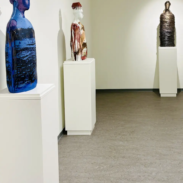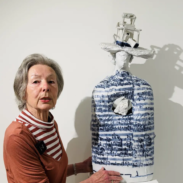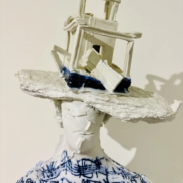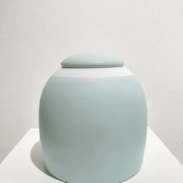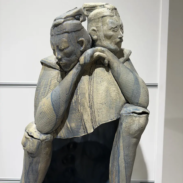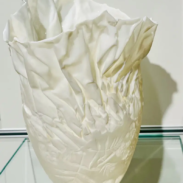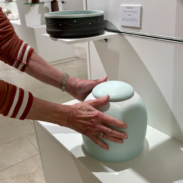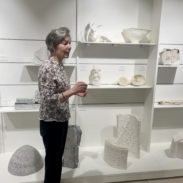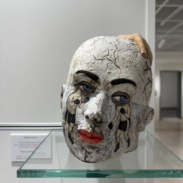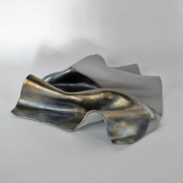
Interview with the Founder Hannelore Seiffert – Part 2
In the second part of our art podcast art talk SaarLorLux about the ‘Kunst Keramik Museum – Stiftung Hannelore Seiffert’ (Hannelore Seiffert Foundation Ceramic Art Museum), founder Hannelore Seiffert tells us exciting stories about her encounters with contemporary ceramic artists and what she has experienced in her 25 years as a collector in the world of ceramic art.
Photo Credits
Cover Foto : © Tom Gundelwein: Paula Bastiaansen, ‘Schneewolke’, Porzellanspirale, 28 x 40 x 20 cm
Verena Feldbausch: 1,3,4,5,7,9, 10,11
Tom Gundelwein: 2
Liane Wilhelmus: 6
JM Schlorke: 8
Pia Treiber: 11
How to activate subtitles in your language
The video contains the original sound, so we have subtitled it for you.
- If no subtitles appear at all, move your mouse pointer into the video window on desktop/mobile computers or tap on the video on mobile devices
- Click on the square icon to the left of the cogwheel to toggle subtitles on/off.
- Normally, the language adapts automatically to your browser language settings.
- If not, you can choose your language by clicking on the cogwheel icon to the left of the YouTube logo.
Introduction to the Second Part of the Podcast
Verena Feldbausch: We talk about art in art talk, the art podcast from SaarLorLux. We meet curators and artists where they are currently exhibiting. Discover contemporary art and extraordinary art spaces in our region with us. Be part of gallery talks, exhibition openings, and finissages. You can listen to art talk wherever there are podcasts. Hello and welcome to the second part of art talk about the Kunst Keramik Museum – Stiftung Hannelore Seiffert in Neunkirchen. Today you can hear interesting stories from the founder herself about her collecting activities over the last 25 years. Enjoy listening, Verena Feldbausch.
Verena Feldbausch: Hello dear Ms. Seiffert and welcome to art talk. Is there a work in your collection that is particularly close to your heart?
Hannelore Seiffert: Take a look around.
Verena Feldbausch: Not just one.
Hannelore Seiffert: Yes, but there are a few focal points. Pieces, for example, from a very dear friend, from the outstanding world-famous artist, Maria Geszler, who also has her own room here. Maria Geszler-Garzuly is Hungarian and has become a world-famous artist as a result, that she introduced screen printing to ceramics and then used it in a completely unconventional way. So she is a very, very free and unconventional artist anyway, as you can see. She comes from a family of musicians and is also very musical herself. Her father was a composer and wrote his own requiem. And when he died, Bela Bartok’s widow played the piano score in the cathedral in Budapest. These are all original scores that were in their possession. And she herself started with the cello. But then she got into trouble with her hands and said, well, then I make ceramics. This was also quite good. And I liked this work here so much because it reflects a personal story. Her son died young, he was highly gifted and wrote books. Of course, this affected her deeply. And that sculpture is called “The Heart of Stone”. Then I asked her, what is that actually up there? What do you mean by that? Because it all has a certain meaning for her. And then she said, this is the house he (her son) could have had. That is now disappearing. These are things like that… but I was also visually fascinated by them as soon as I saw them. I only found out the story afterwards. The special thing about it is the screen printing. You can recognize her work at a glance. So music also plays a very big role in her life. The daughter is in Leipzig at the famous Gewandhaus Orchestra. I think she has a professorship now too. I have 60 pieces from her. Above all, now musical instruments, I have the whole corner full of them. However, we wanted to focus on the figurative works for the first time.
Verena Feldbausch: Oh great, yes, very nice.
Hannelore Seiffert: There are very personal memories associated with it. Or stories that I later attached to some work, i.e. I made up how it could have come about. Then I have a favorite piece. Really, this is a simple and straightforward work of art. But it is excellently made. It comes from South Korea. It is celadon and it is then ground down with a diamond cutter. And it is so indescribably soft. I always have to walk past there. And every time I’m here and just stroke it briefly.
Verena Feldbausch: Yes, please.
Hannelore Seiffert: Because it always got it done at home too, every day.
Verena Feldbausch: This light blue lidded vase is by Ms. Si Sok Kang. And you can find a photo of this lidded vase in our blog.
Hannelore Seiffert: And that was such a beautiful story. I came into the gallery and saw it from a distance. Oh, what’s that? I went there. And there stood a couple. And I always, always had red dots with me. And I went there and had a quick look. And as I had done so, it was all over for me. And they were still talking to each other. And that’s when I got my red point and put it on. And they said, how come, is that sold? Oh, we might have bought it. And I said, I am sorry. And at that moment, the gallery owner arrived. We knew each other. And she greeted me like this. Ah, Ms. Seiffert. And then I said, yes, I’ve already spoken to your employee. And the best thing is, these two have been here in the museum and stood here. And I saw them, I wasn’t sure, but I approached them. And then I said, weren’t you just as interested back then? And they said yes. But we wouldn’t have been able to offer this kind of surrounding to the art work. But they were also beside themselves when they saw me and that they had found the piece here. So they have obviously also explored ceramics intensively. And yes, well, these are the kind of stories, no one would notice and would spontaneously say: this work or none.
Future Projects and Exhibitions
Verena Feldbausch: Do you have a dream for a future project? An exhibition, a publication or a meeting?
Hannelore Seiffert: So exhibition, yes, expansion. As I said, there are still many pieces left. Then I’ve also had a lot of requests from really outstanding artists, if they can donate something. And I know that would be a win, of course. So some of them are very expensive. They would give their work for free to be in this museum, because the museum now also has a very good reputation. Internationally through the International Ceramics Academy. All members are always informed and there have been major reports about it here. And I have already received questions and visits from all over the world. So from Australia, from Japan, from India, from China, from Turkey. And then of course on the other side: USA, Mexico and so on. People are really interested and are then quite fascinated too, because the collection is limited to a relatively short period of time. That’s only about 25 years, the last 25 years. But it really goes into depth and the quality is really impressive.
Memories of the Terracotta Warriors
Verena Feldbausch: We move on to Margret Weise’s ceramics with the name “Doppelfigur”.
Hannelore Seiffert: This, for example, is also a reminder of AIC, whether or not it was made by a German ceramist. But when I was accepted into the AIC, it was in Xi’an, in the city of the Terracotta Warriors. There were seven or eight people who were newly admitted. We were in China for three weeks, before that we were in Beijing. And then there was this official inauguration. And then at the end they pushed in a big board like this and there were individual squares with wet clay in them. And each of us, the newcomers, had to leave a handprint there and write the name and date with our finger. And then they said that this is the clay that the terracotta warriors are made of. And that is now being burned and will remain here.
Verena Feldbausch: That’s great.
Hannelore Seiffert: It amused me at first. And then I thought, gosh, here you can really see what ceramics mean for this country.
Verena Feldbausch: Exactly.
Hannelore Seiffert: I couldn’t imagine anything like that here in Germany. And the terracotta warriors, of course, that’s also a very unusual story, to find them there. And there is an age-old ceramic development and tradition in the country. And you can see that in the current work.
Artists to Watch
Verena Feldbausch: Which artists should we definitely keep an eye on?
Hannelore Seiffert: Actually, I would say everyone, what they see here. A few are no longer alive, but new ones are sure to be added all the time, which I no longer have in mind. So I really have finished my collecting activities, for reasons of space, for reasons of age. If you spend a little time with it, then you can already see which works are particularly interesting. For example, we have filigree work at the back, but which are relatively large, so demanding the highest craftsmanship and that sort of thing. But that is very individual. So I really can’t name any names.
Stories Behind the Works
Verena Feldbausch: Is there a special story behind a particular work in your collection that you would like to tell us about?
Hannelore Seiffert: I’ll start by saying this in general terms, I could tell a special story about almost every piece here, because I know most of the artists personally, because I’ve also seen a lot more of their work, and I have met more often. And then you have a completely different relationship with it. And then also to the pieces, how you bought them. I’m looking at the head here, for example, which is also large on the poster. I met the artist in Dublin, at a congress.
Verena Feldbausch: A quick note, the artist in question is Sergei Isupov. He comes from Russia and now lives in Estonia and Massachusetts. And the work is called “Lecture in Art”. And now back to Hannelore Seiffert.
Hannelore Seiffert: There’s a nice picture where we’re both laughing really happily. So his work is very, very expensive. He had an exhibition himself, so he made me a prize. I felt so honored. I probably wouldn’t have been able to afford it at the time. Just as an example. I was in a gallery in New York, just in passing, I saw two small figures, a pair that belongs together, for 15,000 dollars. It’s been a long time, 15 years ago for sure. That gives you an idea of the price structure. There are already many valuable pieces here. And I could only afford it, because I made an inheritance. My grandfather left me a piece of land. And these were building plots. And they are all here now.
Verena Feldbausch: Very nice. Great realization.
Impact of Ceramic Art on Life
Verena Feldbausch: How has your life with art changed your everyday life? And how has ceramic art changed your view of the world?
Hannelore Seiffert: Yes, if you look around you, that must have been a big change, although I have always been involved with art. So I spend a lot of time at exhibitions, painting and so on. At least once a month and also in a larger radius. So not just in Germany and so on. But then it all came into focus at once. You then sort and become more and more industrious. And then I got more and more invitations. And then I looked up the artists, if I didn’t know them yet, first looked through the Internet or books. I have over 300 ceramic books. Then you delve deeper. And that naturally takes up a good part of our lifetime. With enthusiasm. So this is completely voluntary. Yes, that was the first part of the question.
Verena Feldbausch: And how has ceramic art changed your view of the world?
Hannelore Seiffert: It depends on how you look at it. When I think back to the past in general, I have taken a little distance from current topics. I don’t want to say, I wasn’t interested in politics or anything like that anymore. You always have to be interested. But it was no longer so prominent. And so it really is the case that when I go somewhere, then I’m always looking, unconsciously, for ceramics or museums or galleries or something like that. And this material or this direction has simply come to the fore in my life. I used to read a lot. Now I don’t get to do that much anymore. And that’s the kind of thing I feel sorry for. And I think to myself, well, if the day was a bit longer, that wouldn’t be bad either. But who knows what else I would do with ceramics…
Verena Feldbausch: That’s right.
More Stories and Guided Tours
Verena Feldbausch: Should we go to three more positions? Perhaps different positions where you would like to tell another story? You say that you could of course tell a story about each piece.
Hannelore Seiffert: Definitely, yes.
Verena Feldbausch: Maybe people should just drop by the next time you give a guided tour.
Hannelore Seiffert: I always do guided tours on the second Sunday of every month. So one guided tour per month. I am then also prepared to be very detailed. You have already noticed when the plug is pulled on me. All sorts of things come to light. And as I said, for me this really is my life. So in the sense of living memory. So many images immediately come to mind. And I still talk to many ceramists on the phone all over the world. I just got off the phone with someone from New York yesterday. So there must be four or five phone calls or emails a week with foreign ceramicists anyway. I’m always really happy and stimulated afterwards and think, yes, it’s a nice material after all. Or it’s a fine thing. And even when I come here, as you can see, it’s a big room and it seems totally full. And it is. But then I think, my God, it has all been there with me. And now my house is still full to bursting.
Verena Feldbausch: Yes, it’s crazy. You can’t even imagine that anymore.
Hannelore Seiffert: Yes, that’s just the way it was.
Verena Feldbausch: A great decision.
Hannelore Seiffert: And I really can’t thank Ms. Nix-Hauck enough for this decision. That we were then able to implement it so fantastically.
Verena Feldbausch: Very nice.
Hannelore Seiffert: And we want to add the remaining 170 pieces, roughly speaking, before the end of the year. I recently bought something else. Yes, it had to be. From a great student in Saarbrücken. And there was such a wonderful exhibition. I was there with the museum management and said I’d buy that for the KKM exhibition. Because it hadn’t been recorded yet.
Verena Feldbausch: I was also recently in the HBK Gallery. Were you also at the exhibition of the young students?
Hannelore Seiffert: Yes.
Verena Feldbausch: They simply showed wonderful works.
Hannelore Seiffert: Yes, and so there I have seen it.
Verena Feldbausch: There you have found the work of art. Yes, I thought it was great too. This work was created by Pia Treiber and is from the Ölfleck series (oil stain series). This group of works shows ceramic folds with a very special glaze, which creates the impression of surfaces immersed in crude oil. As always, we post photos of the works discussed in the blog.
Verena Feldbausch: Yes, one can really listen to you endlessly.
Hannelore Seiffert: Yes, I can tell you stories about every piece.
Verena Feldbausch: That’s why you have to come to the museum more often.
Conclusion and Outlook
Verena Feldbausch: Ms. Seiffert, thank you very much for your interesting insights, your passion and your generosity, sharing your art collection with others. If you would now like to find out more about Hannelore Seiffert’s collection and the Ceramic Art Museum in Neunkirchen, then you will find all the links in our show notes. Thank you for listening and hear you in the next episode of art talk SaarLorLux. Your Verena Feldbausch. Did you like art talk? Then leave 5 stars and recommend us to your friends. You can find more information about the podcast in the show notes and on our blog. Be there again when it says: We talk about art at art talk, the art podcast from SaarLorLux.


